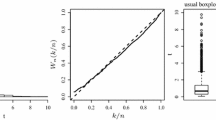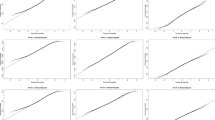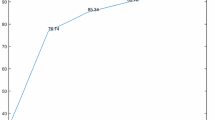Abstract
This paper explores the investors’ feedback to the price change by modelling the price-related dynamics of trading intensity. A component decomposition duration modeling approach, called the component autoregressive conditional duration (CACD) model, is proposed to capture the variation of trading intensity across time intervals between price change events. Based on the CACD model, an empirical analysis is carried out on the Chinese stock market that covers different market statuses. The empirical results suggest that the CACD model can capture the price-related dynamics of trading intensity, which supports the existence of the feedback effect and is robust across different market statuses. The authors also study how the investors react to the price change by examining the driven factors of the price-related dynamics of trading intensity. The authors find that the trading can be triggered by the fast rise in the price level and the high trading volume. Besides, investors are more sensitive to the price change direction in the sideways market than in the upward or downward markets.
Similar content being viewed by others
References
Shiller R J, Fischer S, and Friedman B M, Stock prices and social dynamics, Brookings Papers on Economic Activity, 1984, 1984(2): 457–510.
Shiller R J, Speculative prices and popular models, Journal of Economic Perspectives, 1990, 4(2): 55–65.
De Long J B, Shleifer A, Summers L H, et al., Noise trader risk in financial markets, Journal of Political Economy, 1990, 98(4): 703–738.
De Long J B, Shleifer A, Summers L H, et al., Positive feedback investment strategies and destabilizing rational speculation, Journal of Finance, 1990, 45(2): 379–395.
De Long J B, Shleifer A, Summers L H, et al., The survival of noise traders in financial markets, Journal of Business, 1991, 64: 1–19.
Mendel B and Shleifer A, Chasing noise, Journal of Financial Economics, 2012, 104(2): 303–320.
Sentana E and Wadhwani S, Feedback traders and stock return autocorrelations: Evidence from a century of daily data, The Economic Journal, 1992, 102(411): 415–425.
Koutmos G, Feedback trading and the autocorrelation pattern of stock returns: Further empirical evidence, Journal of International Money and Finance, 1997, 16(4): 325–636.
Watanabe T, Margin requirements, positive feedback trading, and stock return autocorrelations: The case of Japan, Applied Financial Economics, 2002, 12(6): 395–403.
Hasbrouck J, Measuring the information content of stock trades, Journal of Finance, 1991, 46(1): 179–207.
Cohen B H and Shin H S, Positive feedback trading under stress: Evidence from the US Treasury securities market, Working Paper, 2003.
Engle R F and Russell J R, Autoregressive conditional duration: A new model for irregularly spaced transaction data, Econometrica, 1998, 4(2): 1127–1162.
Bauwens L and Giot P, The logarithmic ACD model: An application to the bid-ask quote process of three NYSE stocks, Annales d’Economie et de Statistique, 2000, 60: 117–149.
Zhang M Y, Russell J R, and Tsay R S, A nonlinear autoregressive conditional duration model with applications to financial transaction data, Journal of Econometrics, 2001, 104(1): 179–207.
Hujer R, Vuletic S, and Kokot S, The markov switching ACD model, Working Paper, 2002.
Spierdijk L, An empirical analysis of the role of the trading intensity in information dissemination on the NYSE, Journal of Empirical Finance, 2004, 11(2): 163–184.
Taylor N, Trading intensity, volatility and arbitrage activity, Journal of Banking & Finance, 2004, 28(5): 1137–1162.
Manganelli S, Duration, volume and volatility impact of trades, Journal of Financial Markets, 2005, 8(4): 377–399.
Liu C and Maheu J M, Intraday dynamics of volatility and duration: Evidence from Chinese stocks, Pacific-Basin Finance Journal, 2012, 20(3): 329–348.
Ryu D, Information content of inter-transaction time: A structural approach, Journal of Business Economics and Management, 2015, 16(4): 697–711.
Brownlees C T, Cipollini F, and Gallo G M, Intra-daily volume modeling and prediction for algorithmic trading, Journal of Financial Econometrics, 2011, 9(3): 489–518.
Granger CW and Hyung N, Occasional structural breaks and long memory, Annals of Economics & Finance, 1999, 14(2): 399–421.
Jasiak J, Persistence in intertrade durations, Working Paper, 1999.
Chen W and Deo R, GMM estimation for long memory latent variable volatility and duration models, Working Paper, 2005.
Deo R, Hurvich C M, Soulier P, et al., Conditions for the propagation of memory parameter from durations to counts and realized volatility, Econometric Theory, 2009, 25(3): 764–792.
Brownlees C T and Vannucci M, A Bayesian approach for capturing daily heterogeneity in intradaily durations time series, Studies in Nonlinear Dynamics and Econometrics, 2013, 17(1): 21–46.
Wu Z, On the intraday periodicity duration adjustment of high-frequency data, Journal of Empirical Finance, 2012, 19(2): 282–291.
Andersen T G, Dobrev D, and Schaumburg E, Duration based volatility estimation, Working Paper, 2008.
Tse Y K and Yang T T, Estimation of high-frequency volatility: An autoregressive conditional duration approach, Journal of Business & Economic Statistics, 2012, 30(4): 533–545.
Easley D and O’hara M, Price, trade size, and information in securities markets, Journal of Financial Economics, 1987, 19(1): 69–90.
Easley D and O’hara M, Adverse selection and large trade volume: The implications for market efficiency, Journal of Financial and Quantitative Analysis, 1992, 27(2): 185–208.
Lee C M, Mucklow B, and Ready M J, Spreads, depths, and the impact of earnings information: An intraday analysis, Review of Financial Studies, 1993, 6(2): 345–374.
Shefrin H and Statman M, The disposition to sell winners too early and ride losers too long: Theory and evidence, Journal of Finance, 1985, 40(3): 777–790.
Acknowledgements
The authors thank LU Fengbin, XU Dawei and other seminar participants at the Academy of Mathematics and Systems Science, Chinese Academy of Sciences, for valuable comments.
Author information
Authors and Affiliations
Corresponding author
Additional information
This research was supported by the National Science Foundation of China under Grant Nos. 71201161 and 71671183.
This paper was recommended for publication by Editor ZHANG Xun.
Rights and permissions
About this article
Cite this article
Huang, Z., Han, A. & Wang, S. Component ACD Model and Its Application in Studying the Price-Related Feedback Effect in Investor Trading Behaviors in Chinese Stock Market. J Syst Sci Complex 31, 677–695 (2018). https://doi.org/10.1007/s11424-017-6111-y
Received:
Revised:
Published:
Issue Date:
DOI: https://doi.org/10.1007/s11424-017-6111-y




